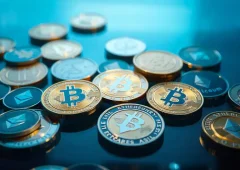Why Robert Kiyosaki Believes Bitcoin Outshines the US Dollar
26.01.2025 8:00 2 min. read Kosta Gushterov
Robert Kiyosaki, author of Rich Dad Poor Dad, has raised a compelling argument for why Bitcoin is a more reliable store of value compared to the US dollar.
While inflation and excessive printing have eroded confidence in fiat currencies, Kiyosaki sees Bitcoin as a rising alternative that offers greater stability and potential for growth.
He explained that Bitcoin, along with precious metals like gold and silver, falls under the category of “good money” in times when the dollar falters. According to Kiyosaki, the principle of Gresham’s Law – where bad money drives out good -applies to today’s economy, with Bitcoin increasingly becoming a safer bet as people seek alternatives to a weakened dollar.
Kiyosaki also pointed to Metcalfe’s Law, which asserts that the value of a network increases with the number of participants. Bitcoin’s expanding global user base strengthens its value, and its decentralized nature further supports its potential. This growing interest is similar to the scaling success seen in major corporations or franchise systems.
Despite this, the CEO of Goldman Sachs, David Solomon, remains skeptical of Bitcoin, seeing it as a speculative asset rather than a true competitor to the US dollar. Nonetheless, Kiyosaki believes the ongoing decline of the dollar, alongside increasing interest in Bitcoin and gold, is a natural shift towards assets that preserve value.
In light of this, Kiyosaki warned that economic instability, driven by irresponsible monetary policies, could lead to an impending market crash. For Kiyosaki, investing in Bitcoin, gold, and silver is the key to safeguarding wealth and riding out these uncertain times.
-
1
Bitcoin ETF Inflows Hit $2.2B as Market Calms After Ceasefire
25.06.2025 17:00 1 min. read -
2
Bitcoin ETF Inflows Explode Past $3.9B as BlackRock’s IBIT Leads the Charge
26.06.2025 18:08 1 min. read -
3
Bitcoin Surpasses Alphabet (Google) to Become 6th Most Valuable Asset Globally
27.06.2025 14:39 2 min. read -
4
Is Bitcoin a Missed Opportunity? This Billionaire Begins to Wonder
27.06.2025 12:00 1 min. read -
5
Bitcoin Price Prediction for the End of 2025 From Standard Chartered
02.07.2025 18:24 1 min. read
Strategy Buys 4,225 more Bitcoin, Pushing Holdings to 601,550 BTC
Bitcoin treasury firm Strategy—formerly known as MicroStrategy—has expanded its already-massive BTC holdings with a fresh $472.5 million acquisition.
Robert Kiyosaki Reacts to Bitcoin’s Surge Past $120K: “I’m Buying One More”
Famed author of Rich Dad Poor Dad, Robert Kiyosaki, has once again thrown his support behind Bitcoin following its recent surge above $120,000, calling it a win for those who already hold the asset—and a wake-up call for those who don’t.
Bitcoin Blasts Past $121,000 [Live blog schema]
Bitcoin has officially broken through the $121,000 level, rising 2.84% in the past 24 hours to hit $121,400, according to CoinMarketCap data.
Bitcoin Blasts Past $121,000 as Institutions Fuel Rally—Will Altcoins Follow?
Bitcoin has officially broken through the $121,000 level, rising 2.84% in the past 24 hours to hit $121,400, according to CoinMarketCap data.
-
1
Bitcoin ETF Inflows Hit $2.2B as Market Calms After Ceasefire
25.06.2025 17:00 1 min. read -
2
Bitcoin ETF Inflows Explode Past $3.9B as BlackRock’s IBIT Leads the Charge
26.06.2025 18:08 1 min. read -
3
Bitcoin Surpasses Alphabet (Google) to Become 6th Most Valuable Asset Globally
27.06.2025 14:39 2 min. read -
4
Is Bitcoin a Missed Opportunity? This Billionaire Begins to Wonder
27.06.2025 12:00 1 min. read -
5
Bitcoin Price Prediction for the End of 2025 From Standard Chartered
02.07.2025 18:24 1 min. read


